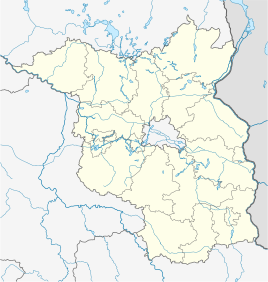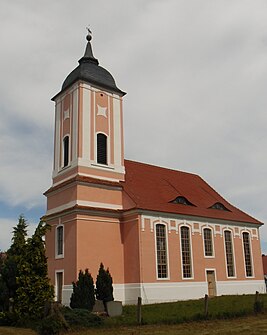Reesdorf (Beelitz)
|
Reesdorf
City of Beelitz
|
||
|---|---|---|
| Coordinates: 52 ° 13 ′ 14 ″ N , 12 ° 55 ′ 15 ″ E | ||
| Height : | 41 m | |
| Area : | 13 km² | |
| Residents : | 116 (March 6, 2015) | |
| Population density : | 9 inhabitants / km² | |
| Incorporation : | December 31, 2001 | |
| Postal code : | 14547 | |
| Area code : | 033204 | |
|
Location of Reesdorf in Brandenburg |
||
|
Village church in Reesdorf
|
||
Reesdorf is a district of the town of Beelitz in the Potsdam-Mittelmark district in the state of Brandenburg . The place is 26 kilometers southwest of the state capital Potsdam on the B 246 between Beelitz and Brück on the western edge of the Nuthe-Nieplitz nature park . Since the major Brandenburg regional reform in 2001, Reesdorf has been part of the city of Beelitz.
history
etymology
Reesdorf was first mentioned in the land book of Charles IV in 1375 as Redichstorpp . Name researchers derive the name from the Slavic personal name Radich . Until the official spelling Reesdorf was determined in 1922, the spellings Regenstroff (1472), Retzdorf (1580), but also Raesdorf , Raeßdorf or Räsdorf have been documented . In a birth certificate from 1888, the spelling “Rähsdorf” appears.
12th to 18th centuries
Since the village was built as a Rundling , experts assume that the foundation is of Slavic origin. The settlement should therefore decrease in the course of the expansion of the Ascanians in the region of the eastern Havel side towards Zauche . However, there is no archaeological evidence for this in Reesdorf so far. From the year the document was mentioned in 1375, ownership of 18 Hufen land has come down to us, three of them for the village mayor . The lack of a jug right suggests that there was no restaurant in the village - in contrast to the more affluent neighboring towns such as Buchholz or Wittbrietzen . Other documents confirm the rather modest life in the village: In several feudal letters, the income of the feudal people from Reesdorf was described as rather low. The same was found in a church visit from 1540. At that time there was no sacred building in Reesdorf . In the late Middle Ages , the inhabitants built a wall around the village, which was probably covered with a thick hedge. It served as protection against robber barons and can only be seen in fragments in the 21st century in a field behind the village towards Brück . In 1586 the parish probably erected a very simple structure in the middle of the village, which was replaced in 1755 by a late Baroque successor building. At that time the tailor was teaching the local children; probably in his room, because there was no school building of its own. In 1772 there were 92 inhabitants in Reesdorf.
19th to 20th century
In the middle of the 19th century, further buildings were built outside the Rundling, which were promoted by the construction of the Berlin – Blankenheim railway line and the facilities in Beelitz-Heilstätten . The population rose sharply and in 1875 there were already 178 people in Reesdorf. Around 1920 the place was connected to the electrical power grid; also opened its own school in the village, in which the children were taught from the 1st to the 8th grade. In 1945, during the Second World War , the site was the scene of sometimes violent fighting between the Red Army and the Wehrmacht . Many people from Reesdorf fled and did not return to a completely destroyed village until the beginning of May 1945. The population rose sharply due to refugees and displaced persons to 207 people in 1950. A few years after the end of the war, school was given up and the children have been attending school in Beelitz since then. In the 1950s and 1960s several LPGs were founded , which were combined with an LPG in Beelitz in 1971. After the reunification , this LPG was also dissolved. In 1990, some residents started a new farm. By the end of the 20th century, the population halved to 103 people.
21st century
Until it was incorporated into Beelitz on December 31, 2001, Reesdorf was an independent municipality that belonged to the district of Zauch-Belzig in the 19th and 20th centuries until it was dissolved . In March 2015 the population was 116. In 2014 the village center was renovated.
coat of arms
| Blazon : "In a gold schrägumwundener from a tape green wreath, from the seven stalked trifoliate green shamrocks from the inside come out to the outside." | |
|
Foundation of the coat of arms: The village is situated between lush meadows, fertile fields and forests. Cattle farming and agriculture have always been practiced here, which should be included in the municipal coat of arms that is to be designed. Farm implements such as plow and ploughshare were suggested as possible coats of arms, as many Reesdorf farmers still have such old implements. After several approaches and drafts, you came up with a wrapped green wreath from which seven clover leaves protrude at equal intervals. With this common heraldic figure, most of the properties of the district could be recorded.
The green wreath stands for the fertile land, the meadows and the solidarity in the village community. On the central, green square in the village, next to the church, there is also a playground and a large, round and paved fireplace - this is where the village festivals take place. The round shape of the village was symbolically taken up by the clover wreath. The shamrocks growing out of the clover wreath stand for families and farms in Reesdorf as well as for luck. The coat of arms was designed by the heraldist Ismet Salahor from Frankfurt and was included in the German local coat of arms at the HEROLD on December 16, 2016 under the number 49BR. |
Attractions
- The Reesdorf village church was probably built in 1775 on the remains of a previous building from the 14th century. The pulpit and the horseshoe gallery date from the construction period; the organ from the mid-19th century.
- Meadow landscape with a lookout tower in the Nieplitzbogen
Web links
Individual evidence
- ↑ Beelitzer Nachrichten, Volume 26, No. 3, Page 9 on yumpu.com, accessed on January 28, 2018
- ↑ Map of the Nuthe Nieplitz Nature Park with precise boundaries . ( Memento of the original from July 14, 2010 in the Internet Archive ) Info: The archive link was inserted automatically and has not yet been checked. Please check the original and archive link according to the instructions and then remove this notice. (PDF; 926 kB) State of Brandenburg, Ministry for the Environment, Health and Consumer Protection (MUGV).
- ↑ Reinhard E. Fischer : The place names of the states of Brandenburg and Berlin , Volume 13 of the Brandenburg Historical Studies on behalf of the Brandenburg Historical Commission, be.bra Wissenschaft, Berlin 2005, p. 140, ISBN 3-937233-30-X , ISSN 1860 -2436 .
- ^ Marianne Kaiser, Helga Kästner, Enrico Rennebarth: Reesdorfer Heimatgeschichte . In: Beelitzer Nachrichten , 2010, No. 4, page 22
- ↑ No birth certificate. 11/1888 of Pauline Bertha Neumann
- ↑ Reesdorf map - a well-rounded affair , on Rundling, March 2017.
- ^ State enterprise for data processing and statistics Brandenburg: Contribution to the statistics: Historical municipality register of the state Brandenburg 1875 to 2005 - Landkreis Potsdam-Mittelmark. (PDF)
- ^ Michael Rademacher: German administrative history from the unification of the empire in 1871 to the reunification in 1990. District Zauch-Belzig. (Online material for the dissertation, Osnabrück 2006).
- ↑ Information on the local coat of arms received directly from the coat of arms designer
- ^ City of Beelitz (ed.): Asparagus city of Beelitz - city with brains . 1st edition. inixmedia north / east, 2014, p. 42 .



